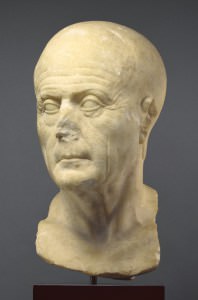To Be Bald, or NOT to be… Hair and Hair Loss in Ancient Rome

Much like men & women today, the people of ancient Rome were very conscious of their hair (or lack thereof). Attitudes toward hair differed greatly depending on a person’s age, sex, and social status. Hair and hair loss was known to be a big topic of stress for Roman men and women alike.
Male Baldness and Its Discontents
A sign of dignity, sternness, and wisdom, male pattern baldness was considered the model characteristic of an honorable Roman citizen, and was used to convey dignity on portraits of philosophers and rulers. Most common in the Republican period, Roman portrait clientele regularly chose to be shown with large noses extra wrinkles, and shiny bald heads, to show the years they had devoted to the Roman state.
While the appearance of partisanship was associated with baldness, it was not as graciously acknowledged to have a receding hairline outside the realm of a portrait and was not nearly as desirable/ or accepted. There were numerous bald Emperors whom lost many nights of sleep over his hair loss (just like many of us!!)
Dyeing Hair: Men would dye and curl their hair in an attempt to avoid thinning or greying, and to hold onto any youthful features.
Hair dyes were removed from bark or walnut shells, carbon, or straight ash. Because both balding and going grey were associated with deteriorating health, aging, and generally losing your mind, hair dye became a popular practice amongst Roman men.
On the other side of the coin, dyeing one’s hair also became a prime opportunity for ridicule. It was seen that any man attempting to hide a receding hairline was in for a relentless mocking from poets:
Ugly are hornless bulls, a field without grass is an eyesore, So is a tree without leaves, so is a head without hair. —Ovid, Ars Amatoria, 3.223–254
Women’s Hair Woes
Just like for men, hair was a major element of both uprightness and physical attractiveness for women. Just like many women today, hair was the first step in any Roman woman’s prep.
All hair endeavors for the wealthy Roman woman would have fallen under the domain of an ornatrix, or beautician skilled at cutting and dyeing hair—shown throughout Greek and Roman art, ironically, as short-haired suited to show her slave status.
These beauticians were responsible for styling hair with dangerous hot tools such as the calamistrum (a cylindrical, fired curling iron), and for sewing in locks of false hair, most often in the form of braids. But female conceit, more than male, was continuously mocked.
A common hairstyle that used hair extensions portrayed a pre-Marie-Antoinette up do. Sometimes a more modest front view hid the extreme up do’s reverse; it held a business in the front, party in the back portrayal (much like the mullet!). For those who couldn’t afford their own personal stylist, there were local hairdressers and barbers.
Aside from the hair on their heads, Roman women often went for the hairless cat look, getting rid of all body hair using pumice stones, wax made from resin, and plucking. However, just like the men discussed earlier, older women who shaved were ridiculed, as this was seen as preparation for romance…looks like there was no winning, man or woman.
After having their hair prepped, Roman women would put on the final touches: shave their eyebrows, swipe their eyelids with soot, and rouge their cheeks with rust and wine.
Opposite from the portraits of their brothers and husbands, Roman women were far more concerned with dawning the latest fashion and beauty than her actual features. Like men, however, Roman women also faced ridicule towards their outward appearance. Criticized for too made-up, and not made-up enough, the struggle for the Romans was all too real.
